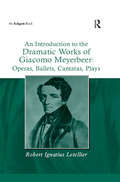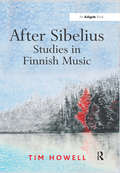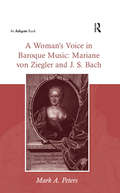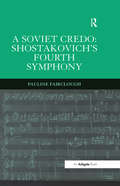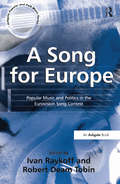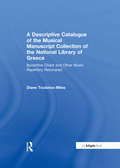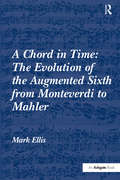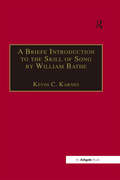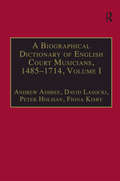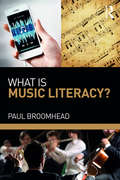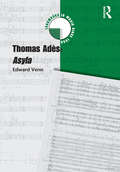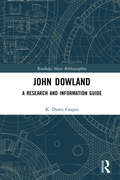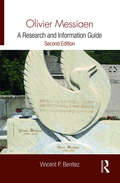- Table View
- List View
An Introduction to the Dramatic Works of Giacomo Meyerbeer: Operas, Ballets, Cantatas, Plays
by Robert Ignatius LetellierGiacomo Meyerbeer (1791-1864) was a great musical dramatist in his own right. The fame of his operas rests on his radical treatment of form, his development of scenic complexes and greater plasticity of structure and melody, his dynamic use of the orchestra, and close attention to all aspects of presentation and production, all of which set new standards in Romantic opera and dramaturgy. This book carries forward the process of rediscovery and reassessment of Meyerbeer‘s artincluding not just his famous French operas, but also his German and Italian ones placing them in the context of his entire dramatic oeuvre, including his ballets, oratorios, cantatas and incidental music. From Meyerbeer‘s first stage presentation in 1810 to his great posthumous accolade in 1865, some 24 works mark the unfolding of this life lived for dramatic music. The reputation of the famous four grand operas may well live on in the public consciousness, but the other works remain largely unknown. This book provides an approachable introduction to them. The works have been divided into their generic types for quick reference and helpful association, and placed within the context of the composer‘s life and artistic development. Each section unfolds a brief history of the work‘s origins, an account of the plot, a critical survey of some of its musical characteristics, and a record of its performance history. Robert Letellier examines each work from a dramaturgical view point, including the essential often challenging philosophical and historical elements in the scenarios, and how these concepts were translated musically onto the stage. A series of portraits and stage iconography assist in bringing the works to life.
After Sibelius: Studies in Finnish Music
by Tim HowellDuring the last twenty years, the rest of the world has come to focus on the music of Finland. The seemingly disproportionate creative energy from this small country defies prevalent trends in the production of classical music. Tim Howell provides an engaging investigation into Finnish music and combines elements of composer biography and detailed analysis within the broader context of cultural and national identity. The book consists of a collection of eight individual composer studies that investigate the historical position and compositional characteristics of a representative selection of leading figures, ranging from the beginning of the twentieth century to the present day. These potentially self-contained studies subscribe to a larger picture, which explains the Sibelian legacy, the effect of this considerable influence on subsequent generations and its lasting consequences: an internationally acclaimed school of contemporary music. Outlining a particular perspective on modernism, Howell provides a careful balance between biographical and analytical concerns to allow the work to be accessible to the non-specialist. Each composer study offers a sense of overview followed by progressively more detail. Close readings of selected orchestral works provide a focus, while the structure of each analysis accommodates the different levels of engagement expected by a wide readership. The composers under consideration are Aarre Merikanto, Erik Bergman, Joonas Kokkonen, Einojuhani Rautavaara, Aulis Sallinen, Paavo Heininen, Kaija Saariaho and Magnus Lindberg. The concluding discussion of issues of national distinctiveness and the whole phenomenon of why such a small nation is compositionally so active, is of wide-ranging significance. Drawing together various strands to emerge from these individual personalities, Howell explores the Finnish attitude to new music, in both its composition and reception, uncovering an enlightened view of the value of creativity from which
After Sibelius: Studies in Finnish Music
by Tim HowellDuring the last twenty years, the rest of the world has come to focus on the music of Finland. The seemingly disproportionate creative energy from this small country defies prevalent trends in the production of classical music. Tim Howell provides an engaging investigation into Finnish music and combines elements of composer biography and detailed analysis within the broader context of cultural and national identity. The book consists of a collection of eight individual composer studies that investigate the historical position and compositional characteristics of a representative selection of leading figures, ranging from the beginning of the twentieth century to the present day. These potentially self-contained studies subscribe to a larger picture, which explains the Sibelian legacy, the effect of this considerable influence on subsequent generations and its lasting consequences: an internationally acclaimed school of contemporary music. Outlining a particular perspective on modernism, Howell provides a careful balance between biographical and analytical concerns to allow the work to be accessible to the non-specialist. Each composer study offers a sense of overview followed by progressively more detail. Close readings of selected orchestral works provide a focus, while the structure of each analysis accommodates the different levels of engagement expected by a wide readership. The composers under consideration are Aarre Merikanto, Erik Bergman, Joonas Kokkonen, Einojuhani Rautavaara, Aulis Sallinen, Paavo Heininen, Kaija Saariaho and Magnus Lindberg. The concluding discussion of issues of national distinctiveness and the whole phenomenon of why such a small nation is compositionally so active, is of wide-ranging significance. Drawing together various strands to emerge from these individual personalities, Howell explores the Finnish attitude to new music, in both its composition and reception, uncovering an enlightened view of the value of creativity from which
A Woman's Voice in Baroque Music: Mariane von Ziegler and J.S. Bach
by MarkA. PetersAt the end of his second year in Leipzig, J.S. Bach composed nine sacred cantatas to texts by Leipzig poet Mariane von Ziegler (1695-1760). Despite the fact that these cantatas are Bach's only compositions to texts by a female poet, the works have been largely ignored in the Bach literature. Ziegler was Germany's first female poet laureate, and the book highlights her significance in early eighteenth-century Germany and her commitment to advancing women's rights of self-expression. Peters enriches and enlivens the account with extracts from Ziegler's four published volumes of poetry and prose, and analyses her approach to cantata text composition by arguing that her distinctive conception of the cantata as a genre encouraged Bach's creative musical realizations. In considering Bach's settings of Ziegler's texts, Peters argues that Bach was here pursuing a number of compositional procedures not common in his other sacred cantatas, including experimentation with the order of movements within a cantata, with formal considerations in arias and recitatives, and with the use of instruments, as well as innovative approaches to Vox Christi texts and to texts dealing with speech and silence. A Woman's Voice in Baroque Music is the first book to deal in depth with issues of women in music in relation to Bach, and one of the few comprehensive studies of a specific repertory of Bach's sacred cantatas. It therefore provides a significant new perspective on both Ziegler as poet and cantata librettist and Bach as cantata composer.
A Woman's Voice in Baroque Music: Mariane von Ziegler and J.S. Bach
by MarkA. PetersAt the end of his second year in Leipzig, J.S. Bach composed nine sacred cantatas to texts by Leipzig poet Mariane von Ziegler (1695-1760). Despite the fact that these cantatas are Bach's only compositions to texts by a female poet, the works have been largely ignored in the Bach literature. Ziegler was Germany's first female poet laureate, and the book highlights her significance in early eighteenth-century Germany and her commitment to advancing women's rights of self-expression. Peters enriches and enlivens the account with extracts from Ziegler's four published volumes of poetry and prose, and analyses her approach to cantata text composition by arguing that her distinctive conception of the cantata as a genre encouraged Bach's creative musical realizations. In considering Bach's settings of Ziegler's texts, Peters argues that Bach was here pursuing a number of compositional procedures not common in his other sacred cantatas, including experimentation with the order of movements within a cantata, with formal considerations in arias and recitatives, and with the use of instruments, as well as innovative approaches to Vox Christi texts and to texts dealing with speech and silence. A Woman's Voice in Baroque Music is the first book to deal in depth with issues of women in music in relation to Bach, and one of the few comprehensive studies of a specific repertory of Bach's sacred cantatas. It therefore provides a significant new perspective on both Ziegler as poet and cantata librettist and Bach as cantata composer.
A Soviet Credo: Shostakovich's Fourth Symphony
by Pauline FaircloughComposed in 1935-36 and intended to be his artistic 'credo', Shostakovich's Fourth Symphony was not performed publicly until 1961. Here, Dr Pauline Fairclough tackles head-on one of the most significant and least understood of Shostakovich's major works. She argues that the Fourth Symphony was radically different from its Soviet contemporaries in terms of its structure, dramaturgy, tone and even language, and therefore challenged the norms of Soviet symphonism at a crucial stage of its development. With the backing of prominent musicologists such as Ivan Sollertinsky, the composer could realistically have expected the premiere to have taken place, and may even have intended the symphony to be a model for a new kind of 'democratic' Soviet symphonism. Fairclough meticulously examines the score to inform a discussion of tonal and thematic processes, allusion, paraphrase and reference to musical types, or intonations. Such analysis is set deeply in the context of Soviet musical culture during the period 1932-36, involving Shostakovich's contemporaries Shebalin, Myaskovsky, Kabalevsky and Popov. A new method of analysis is also advanced here, where a range of Soviet and Western analytical methods are informed by the theoretical work of Shostakovich's contemporaries Viktor Shklovsky, Boris Tomashevsky, Mikhail Bakhtin and Ivan Sollertinsky, together with Theodor Adorno's late study of Mahler. In this way, the book will significantly increase an understanding of the symphony and its context.
A Soviet Credo: Shostakovich's Fourth Symphony
by Pauline FaircloughComposed in 1935-36 and intended to be his artistic 'credo', Shostakovich's Fourth Symphony was not performed publicly until 1961. Here, Dr Pauline Fairclough tackles head-on one of the most significant and least understood of Shostakovich's major works. She argues that the Fourth Symphony was radically different from its Soviet contemporaries in terms of its structure, dramaturgy, tone and even language, and therefore challenged the norms of Soviet symphonism at a crucial stage of its development. With the backing of prominent musicologists such as Ivan Sollertinsky, the composer could realistically have expected the premiere to have taken place, and may even have intended the symphony to be a model for a new kind of 'democratic' Soviet symphonism. Fairclough meticulously examines the score to inform a discussion of tonal and thematic processes, allusion, paraphrase and reference to musical types, or intonations. Such analysis is set deeply in the context of Soviet musical culture during the period 1932-36, involving Shostakovich's contemporaries Shebalin, Myaskovsky, Kabalevsky and Popov. A new method of analysis is also advanced here, where a range of Soviet and Western analytical methods are informed by the theoretical work of Shostakovich's contemporaries Viktor Shklovsky, Boris Tomashevsky, Mikhail Bakhtin and Ivan Sollertinsky, together with Theodor Adorno's late study of Mahler. In this way, the book will significantly increase an understanding of the symphony and its context.
A Song for Europe: Popular Music and Politics in the Eurovision Song Contest
by IVAN RAYKOFF and ROBERT DEAM TOBINThe world's largest and longest-running song competition, the Eurovision Song Contest is a significant and extremely popular media event throughout the continent and abroad. The Contest is broadcast live in over 30 countries with over 100 million viewers annually. Established in 1956 as a televised spectacle to unify postwar Western Europe through music, the Contest features singers who represent a participating nation with a new popular song. Viewers vote by phone for their favourite performance, though they cannot vote for their own country's entry. This process alone reveals much about national identities and identifications, as voting patterns expose deep-seated alliances and animosities among participating countries. Here, an international group of scholars from a variety of disciplines, including musicology, communications, history, sociology, English and German studies, explore how the contest sheds light on issues of European politics, national and European identity, race, gender and sexuality, and the aesthetics of camp. For some countries, participation in Eurovision has been simultaneously an assertion of modernity and a claim to membership in Europe and the West. Eurovision is sometimes regarded as a low-brow camp spectacle of little aesthetic or intellectual value. The essays in this collection often contradict this assumption, demonstrating that the contest has actually been a significant force and forecaster for social, cultural and political transformations in postwar Europe.
A Song for Europe: Popular Music and Politics in the Eurovision Song Contest
by RobertDeam TobinThe world's largest and longest-running song competition, the Eurovision Song Contest is a significant and extremely popular media event throughout the continent and abroad. The Contest is broadcast live in over 30 countries with over 100 million viewers annually. Established in 1956 as a televised spectacle to unify postwar Western Europe through music, the Contest features singers who represent a participating nation with a new popular song. Viewers vote by phone for their favourite performance, though they cannot vote for their own country's entry. This process alone reveals much about national identities and identifications, as voting patterns expose deep-seated alliances and animosities among participating countries. Here, an international group of scholars from a variety of disciplines, including musicology, communications, history, sociology, English and German studies, explore how the contest sheds light on issues of European politics, national and European identity, race, gender and sexuality, and the aesthetics of camp. For some countries, participation in Eurovision has been simultaneously an assertion of modernity and a claim to membership in Europe and the West. Eurovision is sometimes regarded as a low-brow camp spectacle of little aesthetic or intellectual value. The essays in this collection often contradict this assumption, demonstrating that the contest has actually been a significant force and forecaster for social, cultural and political transformations in postwar Europe.
A Descriptive Catalogue of the Musical Manuscript Collection of the National Library of Greece: Byzantine Chant and Other Music Repertory Recovered
by DianeH. Touliatos-MilesThe National Library of Greece (Ethnike Bibliothike tes Ellados) is one of the richest depositories of Byzantine musical manuscripts and is surpassed by its holdings in Greece only by the multitude of manuscripts found in the monasteries of Mount Athos. In spite of being such a rich archive, the National Library has never published a catalogue of its musical manuscripts - not all of which are Byzantine or Greek. It is the purpose of this catalogue to recover or, in some instances, to present for the first time the repertory of the musical sources of the library. This project has been twelve years in the making for Professor Diane Touliatos, involving the discovery and detailed cataloguing of all 241 Western, Ancient Greek, and Byzantine music manuscripts. Not all of these are from Athens or modern Greece, but also encompass Turkey, the Balkans, Italy, Cyprus, and parts of Western Europe. This variety underlines the importance of the catalogue for identifying composers, music and performance practice of different locales. The catalogue includes a detailed listing of the contents as written in the original language as well as the titles of compositions (and/or incipits) with composers, modal signatures, other attributions and information on performance practice. Each manuscript entry includes a commentary in English indicating important highlights and its significance. There is a substantive English checklist that summarizes the contents of each manuscript for non-Greek readers. A bibliography follows containing pertinent citations where the manuscript has been used in references. There is also a glossary that defines terms for the non-specialist. Examples of some of the manuscripts will be photographically displayed. The catalogue will enlighten musicologists and Byzantinists of the rich and varied holdings of some of the most important musical manuscripts in existence, and stimulate more interest and investigation of these sources. As such, it will fill a major ga
A Descriptive Catalogue of the Musical Manuscript Collection of the National Library of Greece: Byzantine Chant and Other Music Repertory Recovered
by DianeH. Touliatos-MilesThe National Library of Greece (Ethnike Bibliothike tes Ellados) is one of the richest depositories of Byzantine musical manuscripts and is surpassed by its holdings in Greece only by the multitude of manuscripts found in the monasteries of Mount Athos. In spite of being such a rich archive, the National Library has never published a catalogue of its musical manuscripts - not all of which are Byzantine or Greek. It is the purpose of this catalogue to recover or, in some instances, to present for the first time the repertory of the musical sources of the library. This project has been twelve years in the making for Professor Diane Touliatos, involving the discovery and detailed cataloguing of all 241 Western, Ancient Greek, and Byzantine music manuscripts. Not all of these are from Athens or modern Greece, but also encompass Turkey, the Balkans, Italy, Cyprus, and parts of Western Europe. This variety underlines the importance of the catalogue for identifying composers, music and performance practice of different locales. The catalogue includes a detailed listing of the contents as written in the original language as well as the titles of compositions (and/or incipits) with composers, modal signatures, other attributions and information on performance practice. Each manuscript entry includes a commentary in English indicating important highlights and its significance. There is a substantive English checklist that summarizes the contents of each manuscript for non-Greek readers. A bibliography follows containing pertinent citations where the manuscript has been used in references. There is also a glossary that defines terms for the non-specialist. Examples of some of the manuscripts will be photographically displayed. The catalogue will enlighten musicologists and Byzantinists of the rich and varied holdings of some of the most important musical manuscripts in existence, and stimulate more interest and investigation of these sources. As such, it will fill a major ga
A Chord in Time: The Evolution of the Augmented Sixth from Monteverdi to Mahler
by Mark EllisFor centuries, the augmented sixth sonority has fascinated composers and intrigued music analysts. Here, Dr Mark Ellis presents a series of musical examples illustrating the 'evolution' of the augmented sixth and the changing contexts in which it can be found. Surprisingly, the sonority emerged from one of the last remnants of modal counterpoint to survive into the tonal era: the Phrygian Cadence. In the Baroque period, the 'terrible dissonance' was nearly always associated with negative textual imagery. Charpentier described the augmented sixth as 'poignantly expressive'. J. S. Bach considered an occurrence of the chord in one of his forebear's motets 'remarkably bold'. During Bach's composing lifetime, the augmented sixth evolved from a relatively rare chromaticism to an almost commonplace element within the tonal spectrum; the chord reflects particular chronological and stylistic strata in his music. Theorists began cautiously to accept the chord, but its inversional possibilities proved particularly contentious, as commentaries by writers as diverse as Muffat, Marpurg and Rousseau reveal. During the eighteenth century, the augmented sixth became increasingly significant in instrumental repertoires - it was perhaps Vivaldi who first liberated the chord from its negative textual associations. By the later eighteenth century, the chord began to function almost as a 'signpost' to indicate important structural boundaries within sonata form. The chord did not, however, entirely lose its darker undertone: it signifies, for example, the theme of revenge in Mozart's Don Giovanni. Romantic composers uncovered far-reaching tonal ambiguities inherent in the augmented sixth. Chopin's Nocturnes often seem beguilingly simple, but the surface tranquillity masks the composer's strikingly original harmonic experiments. Wagner's much-analyzed 'Tristan Chord' resolves (according to some theorists) on an augmented sixth. In Tristan und Isolde, the chord's mercurial
A Chord in Time: The Evolution of the Augmented Sixth from Monteverdi to Mahler
by Mark EllisFor centuries, the augmented sixth sonority has fascinated composers and intrigued music analysts. Here, Dr Mark Ellis presents a series of musical examples illustrating the 'evolution' of the augmented sixth and the changing contexts in which it can be found. Surprisingly, the sonority emerged from one of the last remnants of modal counterpoint to survive into the tonal era: the Phrygian Cadence. In the Baroque period, the 'terrible dissonance' was nearly always associated with negative textual imagery. Charpentier described the augmented sixth as 'poignantly expressive'. J. S. Bach considered an occurrence of the chord in one of his forebear's motets 'remarkably bold'. During Bach's composing lifetime, the augmented sixth evolved from a relatively rare chromaticism to an almost commonplace element within the tonal spectrum; the chord reflects particular chronological and stylistic strata in his music. Theorists began cautiously to accept the chord, but its inversional possibilities proved particularly contentious, as commentaries by writers as diverse as Muffat, Marpurg and Rousseau reveal. During the eighteenth century, the augmented sixth became increasingly significant in instrumental repertoires - it was perhaps Vivaldi who first liberated the chord from its negative textual associations. By the later eighteenth century, the chord began to function almost as a 'signpost' to indicate important structural boundaries within sonata form. The chord did not, however, entirely lose its darker undertone: it signifies, for example, the theme of revenge in Mozart's Don Giovanni. Romantic composers uncovered far-reaching tonal ambiguities inherent in the augmented sixth. Chopin's Nocturnes often seem beguilingly simple, but the surface tranquillity masks the composer's strikingly original harmonic experiments. Wagner's much-analyzed 'Tristan Chord' resolves (according to some theorists) on an augmented sixth. In Tristan und Isolde, the chord's mercurial
A Briefe Introduction to the Skill of Song by William Bathe
by William Bathe and Kevin C. KarnesAlthough unjustly neglected by modern writers, William Bathe‘s contributions to music pedagogy in late sixteenth-century England were profound. Bathe‘s A Briefe Introduction to the Skill of Song (1596) not only includes the first explication of a four-syllable, non-hexachordal solmization method published by an English writer (a system similar to that which would become the standard in England during the seventeenth century) but also outlines a combinatorial method for composing canons that is remarkably forward-looking in both conception and design. In addition to providing the first modern edition of Bathe‘s treatise, the volume examines the complicated compilation and publication histories of the book, the historical and theoretical foundations of Bathe‘s contributions, and the relationship between the 1596 book and Bathe‘s 1584 treatise A Briefe Introduction to the True Arte of Musicke (the extant text of which is included as an appendix).
A Briefe Introduction to the Skill of Song by William Bathe
by Kevin C. KarnesAlthough unjustly neglected by modern writers, William Bathe‘s contributions to music pedagogy in late sixteenth-century England were profound. Bathe‘s A Briefe Introduction to the Skill of Song (1596) not only includes the first explication of a four-syllable, non-hexachordal solmization method published by an English writer (a system similar to that which would become the standard in England during the seventeenth century) but also outlines a combinatorial method for composing canons that is remarkably forward-looking in both conception and design. In addition to providing the first modern edition of Bathe‘s treatise, the volume examines the complicated compilation and publication histories of the book, the historical and theoretical foundations of Bathe‘s contributions, and the relationship between the 1596 book and Bathe‘s 1584 treatise A Briefe Introduction to the True Arte of Musicke (the extant text of which is included as an appendix).
A Biographical Dictionary of English Court Musicians, 1485-1714, Volumes I and II
by David LasockiCompiled by scholars with unrivalled knowledge of the sources, this dictionary provides biographies of all musicians and instrument makers employed by the English court from 1485-1714. A number of the musicians featured here have never previously received a dictionary entry. Coverage of these minor figures helps to flesh out the picture of musical life in the court in a way which individual studies of more major composers cannot. In addition to basic biographical details, entries feature information on: appointments; probate material; family background; heraldry; signatures and holograph documents; subscriptions to books; bibliographic references. A finding-list of variant names, details of the succession of court places assumed by musicians and an index of subjects and place names completes this comprehensive reference work.
A Biographical Dictionary of English Court Musicians, 1485-1714, Volumes I and II
by David LasockiCompiled by scholars with unrivalled knowledge of the sources, this dictionary provides biographies of all musicians and instrument makers employed by the English court from 1485-1714. A number of the musicians featured here have never previously received a dictionary entry. Coverage of these minor figures helps to flesh out the picture of musical life in the court in a way which individual studies of more major composers cannot. In addition to basic biographical details, entries feature information on: appointments; probate material; family background; heraldry; signatures and holograph documents; subscriptions to books; bibliographic references. A finding-list of variant names, details of the succession of court places assumed by musicians and an index of subjects and place names completes this comprehensive reference work.
What is Music Literacy?
by Paul BroomheadWhat is Music Literacy? attempts to redefine music literacy with a more expansive meaning than is commonly in use, and to articulate the potential impact of these ideas on music teaching practice. The notion of music literacy has involved the ability to read and write music scores. However, this understanding does not extend theory to identify all music texts, nor to offer a thorough treatment of what impact an expanded notion of music literacy might have on music instruction in the classroom and in ensembles. This book provides a formal, expansive redefinition of music literacy. The author offers practical ideas for attending more effectively to music literacy in classroom instruction. The book highlights common elements in the music classroom: the music score, the conductor, surrounding ensemble members, the musical model, the musical instrument, and presentations/recordings. It also describes four orientations that correspond to the National Core Music Standards (2014) and that characterize humans’ interactions with music: creator, performer, responder, and connector. What is Music Literacy? uses these orientations, along with a focus on authentic music texts and literacies, to present literacy-based guidelines for music education along with numerous vignettes that describe actual literacy instructional events.
What is Music Literacy?
by Paul BroomheadWhat is Music Literacy? attempts to redefine music literacy with a more expansive meaning than is commonly in use, and to articulate the potential impact of these ideas on music teaching practice. The notion of music literacy has involved the ability to read and write music scores. However, this understanding does not extend theory to identify all music texts, nor to offer a thorough treatment of what impact an expanded notion of music literacy might have on music instruction in the classroom and in ensembles. This book provides a formal, expansive redefinition of music literacy. The author offers practical ideas for attending more effectively to music literacy in classroom instruction. The book highlights common elements in the music classroom: the music score, the conductor, surrounding ensemble members, the musical model, the musical instrument, and presentations/recordings. It also describes four orientations that correspond to the National Core Music Standards (2014) and that characterize humans’ interactions with music: creator, performer, responder, and connector. What is Music Literacy? uses these orientations, along with a focus on authentic music texts and literacies, to present literacy-based guidelines for music education along with numerous vignettes that describe actual literacy instructional events.
Thomas Adès: Asyla (Landmarks in Music Since 1950)
by Edward VennThomas Adès (b. 1971) is an established international figure, both as composer and performer, with popular and critical acclaim and admiration from around the world. Edward Venn examines in depth one of Adès’s most significant works so far, his orchestral Asyla (1997). Its blend of virtuosic orchestral writing, allusions to various idioms, including rave music, and a musical rhetoric encompassing both high modernism and lush romanticism is always compelling and utterly representative of Adès’s distinctive compositional voice. The reception of Asyla since its premiere in 1997 by Sir Simon Rattle and the City of Birmingham Symphony Orchestra (CBSO) has been staggering. Instantly hailed as a classic, Asyla won the 1997 Royal Philharmonic Society Award for Large-Scale Composition. An internationally acclaimed recording made of the work was nominated for the 1999 Mercury Music Prize, and in 2000, Adès became the youngest composer (and only the third British composer) to win the Grawemeyer prize, for Asyla. Asyla is fast becoming a repertory item, rapidly gaining over one hundred performances: a rare distinction for a contemporary work.
Thomas Adès: Asyla (Landmarks in Music Since 1950)
by Edward VennThomas Adès (b. 1971) is an established international figure, both as composer and performer, with popular and critical acclaim and admiration from around the world. Edward Venn examines in depth one of Adès’s most significant works so far, his orchestral Asyla (1997). Its blend of virtuosic orchestral writing, allusions to various idioms, including rave music, and a musical rhetoric encompassing both high modernism and lush romanticism is always compelling and utterly representative of Adès’s distinctive compositional voice. The reception of Asyla since its premiere in 1997 by Sir Simon Rattle and the City of Birmingham Symphony Orchestra (CBSO) has been staggering. Instantly hailed as a classic, Asyla won the 1997 Royal Philharmonic Society Award for Large-Scale Composition. An internationally acclaimed recording made of the work was nominated for the 1999 Mercury Music Prize, and in 2000, Adès became the youngest composer (and only the third British composer) to win the Grawemeyer prize, for Asyla. Asyla is fast becoming a repertory item, rapidly gaining over one hundred performances: a rare distinction for a contemporary work.
John Dowland: A Research and Information Guide (Routledge Music Bibliographies)
by K. Dawn GrapesJohn Dowland: A Research and Information Guide offers the first comprehensive guide to the musical works and literature on one of the major composers of the English Renaissance. Including a catalog of works, discography of recordings, extensive annotated bibliography of secondary sources, and substantial indexes, this volume is a major reference tool for all those interested in Dowland's works and place in music history, and a valuable resource for researchers of Renaissance and English music.
John Dowland: A Research and Information Guide (Routledge Music Bibliographies)
by K. Dawn GrapesJohn Dowland: A Research and Information Guide offers the first comprehensive guide to the musical works and literature on one of the major composers of the English Renaissance. Including a catalog of works, discography of recordings, extensive annotated bibliography of secondary sources, and substantial indexes, this volume is a major reference tool for all those interested in Dowland's works and place in music history, and a valuable resource for researchers of Renaissance and English music.
Olivier Messiaen: A Research and Information Guide (Routledge Music Bibliographies)
by Vincent BenitezOlivier Messiaen: A Research and Information Guide, Second Edition presents researchers with the most significant and helpful resources on Olivier Messiaen, one of the twentieth century's greatest composers. With multiple indices, this annotated bibliography will serve as an excellent tool for librarians, researchers, and scholars sorting through the massive amount of material in the field. The second edition has been fully revised and updated.
Olivier Messiaen: A Research and Information Guide (Routledge Music Bibliographies)
by Vincent BenitezOlivier Messiaen: A Research and Information Guide, Second Edition presents researchers with the most significant and helpful resources on Olivier Messiaen, one of the twentieth century's greatest composers. With multiple indices, this annotated bibliography will serve as an excellent tool for librarians, researchers, and scholars sorting through the massive amount of material in the field. The second edition has been fully revised and updated.
